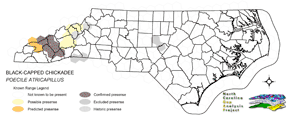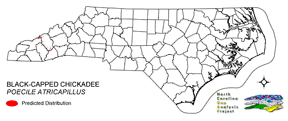
| Taxa: |
| Order: |
| Family: |
| Aves |
| Passeriformes |
| Paridae |
| NatureServe Global Rank: |
| NatureServe State (NC) Rank: |
| G5 |
| S3 |
| Federal Status: |
| NC State Status: |
| --- |
| SC |


| Land Unit |
| US Fish & Wildlife Service |
| US Forest Service |
| US National Park Service |
| US Department of Defense |
| NC State Parks |
| NC University System |
| NC Wildlife Res. Com. |
| NC Forest Service |
| NC Div. of Coastal Mgmt. |
| Local Governments |
| Non-Governmental Org. |
| Other Public Lands |
| Private Lands |
| GAP Status 1-2 |
| All Protected Lands |
| Statewide |
| Hectares |
| 0.00 |
| 4,352.58 |
| 0.00 |
| 10,340.55 |
| 0.00 |
| 0.00 |
| 9.72 |
| 0.00 |
| 0.00 |
| 117.72 |
| 37.80 |
| 0.00 |
| 2,715.75 |
| 12,240.81 |
| 14,850.45 |
| 17,574.12 |
| Acres |
| 0.00 |
| 10,755.46 |
| 0.00 |
| 25,552.05 |
| 0.00 |
| 0.00 |
| 24.02 |
| 0.00 |
| 0.00 |
| 290.89 |
| 93.41 |
| 0.00 |
| 6,710.76 |
| 30,247.69 |
| 36,696.25 |
| 43,426.59 |
| % of Dist. on |
| Prot. Lands |
| 0.0 % |
| 29.3 % |
| 0.0 % |
| 69.6 % |
| 0.0 % |
| 0.0 % |
| < 0.1 % |
| 0.0 % |
| 0.0 % |
| 0.2 % |
| 0.2 % |
| 0.0 % |
| 0.0 % |
| 82.4 % |
| ----- |
| ----- |
| % of Dist. on |
| All Lands |
| 0.0 % |
| 24.8 % |
| 0.0 % |
| 58.8 % |
| 0.0 % |
| 0.0 % |
| < 0.1 % |
| 0.0 % |
| 0.0 % |
| 0.7 % |
| 0.2 % |
| 0.0 % |
| 15.5 % |
| 69.7 % |
| ----- |
| ----- |
|
Found within the spruce-fir and northern hardwood forests in the higher elevations of mountains in NC (Hamel 1992, Simpson 1992). Breeds in high elevation habitats, i.e. spruce-fir and northern hardwoods (Simpson 1992). Rather mature stands are preferred, as dead trees and stubs are more prevalent for nesting (Hamel 1992). Kaufman (1996) list the Black-capped chickadee is 'most common in open woods and forest edge,' and goes on to state it 'avoids purely coniferous forests.' Nests are generally excavated in dead trees, 5 to 60 above the ground (Potter et al 1980). Old woodpecker holes are used occasionally (Kaufman 1996). Material placed in the cavity for the nest include: soft plant fibers, hair, wool, feathers, moss, fur, cottony fibers, and insect cocoons (Potter et al 1980). Kaufman (1996) describes foraging behavior as 'hopping among the twigs and branches and gleaning food from surface, often hanging upside down to reach underside of branches.' Typically insects and small invertebrates make up their summer diet (Hamel 1992). NATURE SERVE GLOBAL HABITAT COMMENTS: Deciduous and mixed forest and woodland, tall thickets, open woodland and parks. See Schroeder (1990) for tests of a habitat suitability model. Nests in cavity dug by both sexes in tree, in natural cavity, old woodpecker hole, in bird box, or artificial snag (Grubb and Bronson 1995, Condor 97:1067- 1070). NATURE SERVE STATE HABITAT COMMENTS: Breeds primarily in mature spruce-fir forests. In the Smokies it is widespread in mixed forests above 4500 feet and breeds in hardwood forests above 4000 feet. Outside the Smokies, it is almost entirely limited to spruce-fir above 5000 ft. |
| Code | Name | Description | NC Natural Heritage Program Equivalent |
| 521 | Spruce/Fir Forest | High Elevation Frazer-Fir - Red Spruce, Red Spruce and Red-Spruce-Yellow Birch Forests. Tree densities included here include both woodland to forest density. Highly intermixed with Northern Hardwoods, Grassy Balds, and Shrub Balds. | Red Spruce--Fraser Fir Forest, Fraser Fir Forest |
| 522 | Northern Hardwoods | High Elevation forests including yellow birch, American beech, and yellow buckeye. Includes forests with Hemlock and Yellow Birch. | Northern Hardwoods Forest, Boulderfield Forest |
|
Hamel, P. B. 1992. The land manager's guide to the birds of the south. The Nature Conservancy, Chapel Hill, North Carolina. 367 pp + several appendices.
Simpson MB Jr. 1992. Birds of the Blue Ridge Mountains. Chapel Hill and London: University of North Carolina Press. Kaufman K. 1996. Lives of North American Birds. Boston, New York: Houghton Mifflin Company. Potter, E. F., J. F. Parnell, and R. P. Teulings. 1980. Birds of the Carolinas. Univ. North Carolina Press, Chapel Hill. 408 pp. Schroeder, R. L. 1990. Tests of a habitat suitability model for black-capped chickadees. U.S. Fish and Wildl. Serv. Biol. Rep. 90(10). 8 pp. |
For more information please contact them at:
NC-GAP Analysis Project
Dept. of Zoology, NCSU
Campus Box 7617
Raleigh, NC 27695-7617
(919) 513-2853
www.basic.ncsu.edu/ncgap